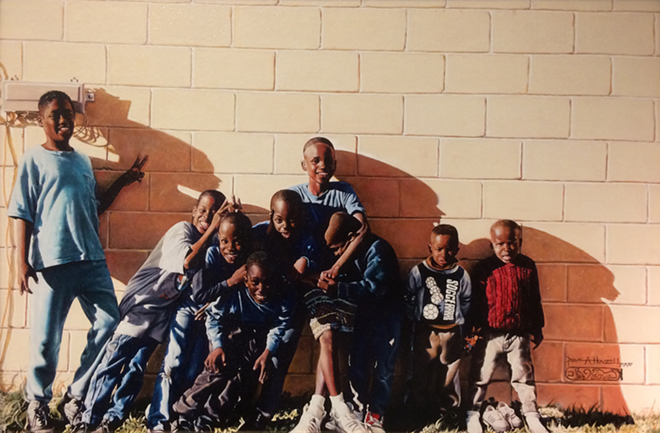From the works of Kerry James Marshall to Kehinde Wiley, figure painting is easily making a comeback through the thicket of abstract paintings in galleries and museums — and in a big way. It’s no wonder why, though, because everyone loves a good story, and figurative work is a great entry into a narrative. Paul Antonelleo Houzell uses the human figure in his solo exhibition Paintings that Heal in the Sacred Phi at the Dr. Carter G. Woodson Museum to speak about education, humanitarianism, spirituality, and healing as a community.
First, you have to give credit to an artist that isn’t afraid to go for a few completely different styles to chase down content. Taking a glimpse around the exhibition, there are so many bodies of work in different styles that while it may look like a group exhibition, Houzell’s distinct mark still shows through even though he may not stick to a ‘signature style.’
Regardless, traditional realism is his mainstay as a self-taught painter, with impressive portraits like “Old Man — WWII Veteran.” Even from across the room, the man’s well-weathered skin glows with a kind of warmth that seems to come from within the painting. His solemn facial expression and darkened eyes hint to the horrors he witnessed during wartime. Though Houzell concerns himself with communication and healing through the arts, he doesn’t mention using beauty as tools to reach those ends, which he does with arresting results.
It’s obvious the public both wants and needs diversity in the arts.
Egyptian and African symbols are seen throughout the exhibition, like in “Can’t Touch This — It’s Hammer Time,” which is a pretty lighthearted title from an anthem of a song for a painting that’s more serious in tone. A young black girl cloaked in a red veil clutches a book to her body, only her eyes peering over the top of it, using it as a shield as if she is protected by its knowledge. She also holds a Heqa scepter (the shepherd’s hook), which is associated with rulers, and is paired with the flail (staff with the dangling doo-dad) to show who’s in charge. As the saying goes, “Knowledge is power,” but the power of the girl’s piercing stare in this image is enough command to leave an impression on any viewer.
You can see Houzell starting to add hardedge lines in the background of his Hammer Time piece, but he goes all out with geometric abstraction in his “Crucifixion of the Golden Triangle.” As an extreme venture from his classical portraits, his technical skill remains unmistakable with the rendering of Egyptian eyes across the horizontal beam of the golden cross. Using a limited palette and sacred geometry, he combines formal elements with symbolism and elements of the figure to create hints of the outline of a face, or a makeshift nose and mouth as seen in the notches of the cross.

One of my favorites, though, is not a particularly momentous point in time, but a moment of daily happiness found in the painting “Horsing Around on the Wall at Joe Louis St. Apartments.” Countering the other portraits’ more static poses, this painting is full of motion. One boy with a sheepish smile holds another boy in a mild headlock while two of the youngest of the crew stand off to the right with their backs against the wall. The oldest boy leans towards the dogpile holding up a peace sign, acting as a guardian to his brothers. Their long shadows run along the wall of the building, where the tan bricks could equally be seen as pyramid bricks, linking this contemporary scene with Houzell’s mission of connecting heritages back to their roots. Where many might look at these boys while driving by and sense trouble, Houzell shows the carefree play of these boys as they lean into each other for support — they are just kids having fun.
With the recent opening of the Smithsonian’s National Museum of African American History and Culture (to insane crowds, I might add), it’s obvious the public both wants and needs diversity in the arts. As an art educator, the artist nurtures young African Americans and Latinos to see the value in using art to improve communication between themselves and the world around them. Since the figure has and always will be relevant and relatable to the masses, Houzell uses empathy towards his subject as an entryway for viewers to begin understanding diversity.
As an artist, it can be easy to pinpoint and focus on the hardships and criticisms of life. While Houzell knows and acknowledges this, his works rise above the anger and seem to truly be working towards camaraderie between humans of all backgrounds.
Paintings that Heal in the Sacred Phi, by Paul Antonelleo Houzell
Through Dec. 31.
Dr. Carter G. Woodson African American Museum, 2240 9th St. S., St. Pete.

